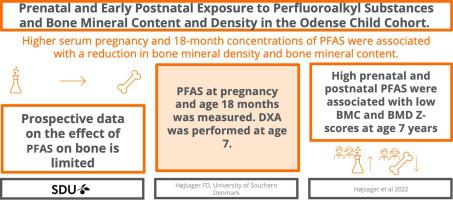Environment International ( IF 10.3 ) Pub Date : 2022-07-16 , DOI: 10.1016/j.envint.2022.107417 F D Højsager 1 , M Andersen 2 , A Juul 3 , F Nielsen 1 , S Möller 4 , H T Christensen 5 , A Grøntved 6 , P Grandjean 7 , T K Jensen 8

|
Introduction
Exposure to perfluoroalkyl substances (PFAS) has been associated with lower bone mineral density (BMD) in animal and human studies, but prospective data from children are limited.
Objectives
To determine associations between prenatal and early postnatal PFAS exposure and BMD at age 7 years.
Methods
In the Odense Child Cohort, Denmark, pregnant women were recruited in 2010–2012, and their children were invited for subsequent health examinations. At 12 weeks of gestation the pregnant women delivered a serum sample, and at age 18 months serum was obtained from the child to measure perfluorooctane sulfonic acid (PFOS), perfluorooctanoic acid (PFOA), perfluorohexane sulfonic acid (PFHxS), perfluorononanoic acid (PFNA) and perfluorodecanoic acid (PFDA) by LC-MS/MS. At age 7 years DXA scans were performed to measure bone mineral content (BMC) and BMD Z-score. PFAS in pregnancy (n = 924) and/or at age 18 months (n = 511) were regressed against DXA measurements, adjusted for maternal education, child height Z-score, sex (for BMC) and for postnatal exposure, additionally duration of total breastfeeding. We additionally performed structural equation models determining combined effects of pre-and postnatal PFAS exposures.
Results
Higher prenatal and early postnatal serum concentrations of all measured PFAS were associated with lower BMC and BMD Z-scores at age 7 years, all estimates were negative although not all significant. For each doubling of prenatal or 18-month exposure to PFDA, BMD Z-scores were lowered by −0.07 (95 % CI −0.10; −0.03) and −0.14 (−0.25; −0.03), respectively after adjustment. Pre- and postnatal PFAS were correlated, but structural equation models suggested that associations with BMD were stronger for 18-month than prenatal PFAS exposure.
Discussion
Bone density is established in childhood, and a reduction in BMD during early childhood may have long-term implication for peak bone mass and lifelong bone health. Future studies of the impact of PFAS exposure on fracture incidence will help elucidate the clinical relevance.
中文翻译:

欧登塞儿童队列的产前和产后早期接触全氟烷基物质以及骨矿物质含量和密度
介绍
在动物和人类研究中,接触全氟烷基物质 (PFAS) 与骨矿物质密度 (BMD) 降低有关,但来自儿童的前瞻性数据有限。
目标
旨在确定产前和产后早期 PFAS 暴露与 7 岁时 BMD 之间的关联。
方法
丹麦欧登塞儿童队列在2010-2012年招募了孕妇,并邀请她们的孩子进行随后的健康检查。妊娠 12 周时,孕妇提供血清样本,并在 18 个月时从孩子处获取血清,以测量全氟辛烷磺酸 (PFOS)、全氟辛酸 (PFOA)、全氟己烷磺酸 (PFHxS)、全氟壬酸 (PFNA) ) 和全氟癸酸 (PFDA),通过 LC-MS/MS 测定。7 岁时进行 DXA 扫描以测量骨矿物质含量 (BMC) 和 BMD Z 分数。根据 DXA 测量值对妊娠期 (n = 924) 和/或 18 个月 (n = 511) 时的 PFAS 进行回归,并根据母亲教育程度、儿童身高 Z 分数、性别(对于 BMC)和产后暴露以及产后暴露时间进行调整。完全母乳喂养。我们还建立了结构方程模型来确定产前和产后 PFAS 暴露的综合影响。
结果
所有测量的 PFAS 的产前和产后早期血清浓度较高,与 7 岁时 BMC 和 BMD Z 分数较低相关,所有估计值均为负值,但并非全部显着。产前或 18 个月 PFDA 暴露量每增加一倍,调整后 BMD Z 评分分别降低 -0.07 (95% CI -0.10; -0.03) 和 -0.14 (-0.25; -0.03)。产前和产后 PFAS 是相关的,但结构方程模型表明,18 个月内与 BMD 的相关性比产前 PFAS 暴露的相关性更强。
讨论
骨密度在儿童时期就已经确定,儿童早期骨密度的降低可能对峰值骨量和终生骨骼健康产生长期影响。未来关于 PFAS 暴露对骨折发生率影响的研究将有助于阐明临床相关性。










































 京公网安备 11010802027423号
京公网安备 11010802027423号